5 Charts That Illustrate The Racial Bias In The Nonprofit World
Of all the things philanthropists are trying to fix, there’s one major issue the sector seems to continually ignore: itself. As a new report by the Building Movement Project, a nonprofit research group, points out, there’s an intense lack of racial diversity among nonprofit and foundation leaders, an issue that remains unaddressed despite having been well documented for at least 15 years. Considering equality and social progress are supposed to be a core facet of cause work, the lack of commitment to that within the industry’s offices and boardrooms is perplexing.
Or at least that’s the polite word for it. Another one would arguably be “discriminatory.” As has already been widely reported, white people hold more than 80% of the industry’s top positions. That leads to homogeneity in approaches to problem solving, and lowers the chances that those in power might actually understand root concerns within the diverse populations they serve.
And things get even more homogeneous (closer to 90% white) when the field is narrowed to the largest 315 nonprofits and foundations, according to another study by Battalia Winston, a recruiting group. That means the people within places that can potentially make the biggest difference are probably way too much alike.
There are lots of ways to try to explain away the disparity, including default explanations: that there may be a lack of qualified candidates or that people of color aren’t as interested in top-level positions. The truth, of course, is the exact opposite, according to BMP, whose report is entitled “Race to Lead”: After surveying more than 4,000 people within the philanthropy world, the group has developed an extremely clear picture of the industry’s scope of inequality, how it works, and why it continues to persist.
Here are five charts that tell that story:
All Top-Level Candidates Start Out Equal
As you can see in the pie chart, there’s not much difference between the baseline credentials of white people and people of color in the sector. The white population has an incrementally greater collection of bachelors and masters degrees, while people of color are more likely to have advanced doctorates or law or medical degrees.
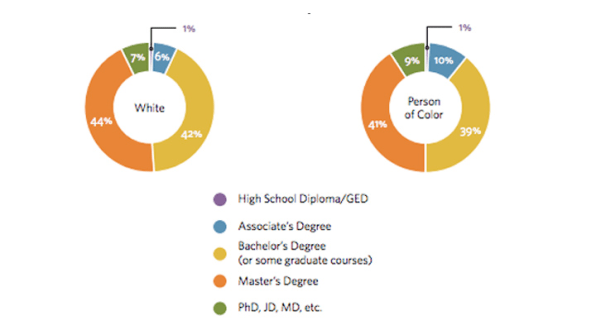
Minorities Are More Interested in Being Promoted
When BMP researchers asked the following question—”Are you interested in becoming an executive director/CEO of a nonprofit someday”—more than 50% of minority candidates said yes. That’s actually 10% more than their white counterparts.
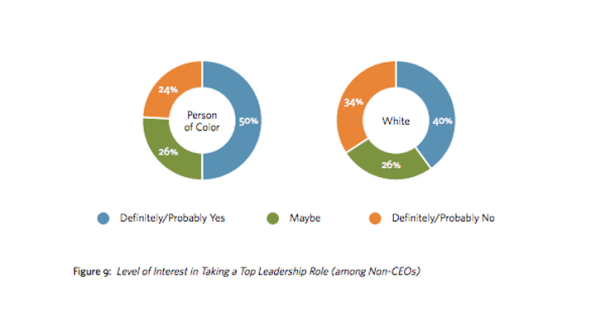
But Recruiters and Hiring Boards Are Often Biased
Regardless of race, the majority of those within the industry agree that recruiters aren’t doing enough to find and court qualified diverse candidates for top-level positions. But many minorities feel like they’ll be denied because they’re not the right “fit,” an intangible that study authors suggest represents “implicit bias.”
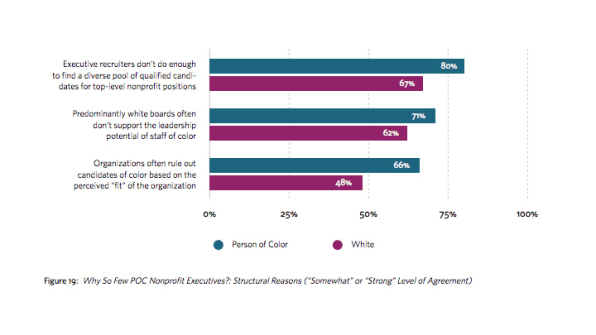
And Whiteness Perpetuates More Whiteness
To highlight exactly how the racial gap continues, Community Wealth Partners, a social entrepreneurship consultancy, created the following flow chart.
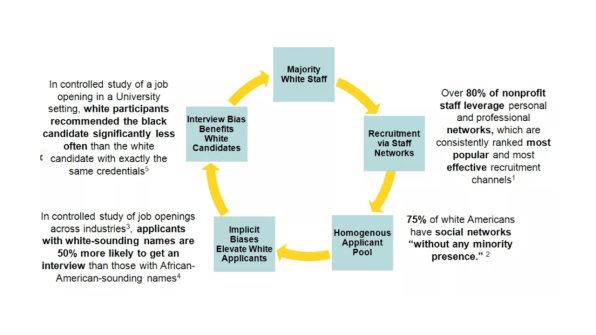
The group found over 80% of nonprofit staff recruit from their own professional networks. That’s a problem because 75% of white Americans don’t have any minorities in those networks. Add to that the fact that applicants with stereotypically white names are reportedly 50% more likely to get an interview than those with African-American ones. And white hirers have been shown to recommend white candidates over black candidates when all things are equal.
That Creates A Toxic Environment With Uneven Standards
As the graph below shows, people of color within the philanthropy field are far less likely to want to work in white dominant organizations. Many believe there’s an unfair standard for promotion, meaning they need to develop more skills and training that normal because their white counterparts receive an unfair advantage. Success only breeds more complications, as many minorities think that discrimination from funders might hurt their ability to raise money.
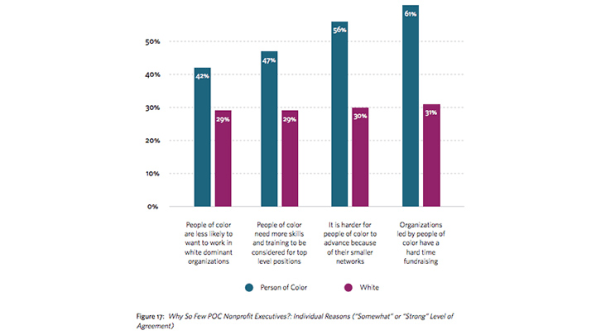
Tellingly, more than 20% of those minority respondents uninterested in chasing leadership positions were considering leaving the profession entirely.
Find the full report, along with BMP’s suggestions for how groups can become more accountable here.
White people hold more than 80% of the industry’s top positions.
Of all the things philanthropists are trying to fix, there’s one major issue the sector seems to continually ignore: itself. As a new report by the Building Movement Project, a nonprofit research group, points out, there’s an intense lack of racial diversity among nonprofit and foundation leaders, an issue that remains unaddressed despite having been well documented for at least 15 years. Considering equality and social progress are supposed to be a core facet of cause work, the lack of commitment to that within the industry’s offices and boardrooms is perplexing.
Fast Company , Read Full Story
(37)














